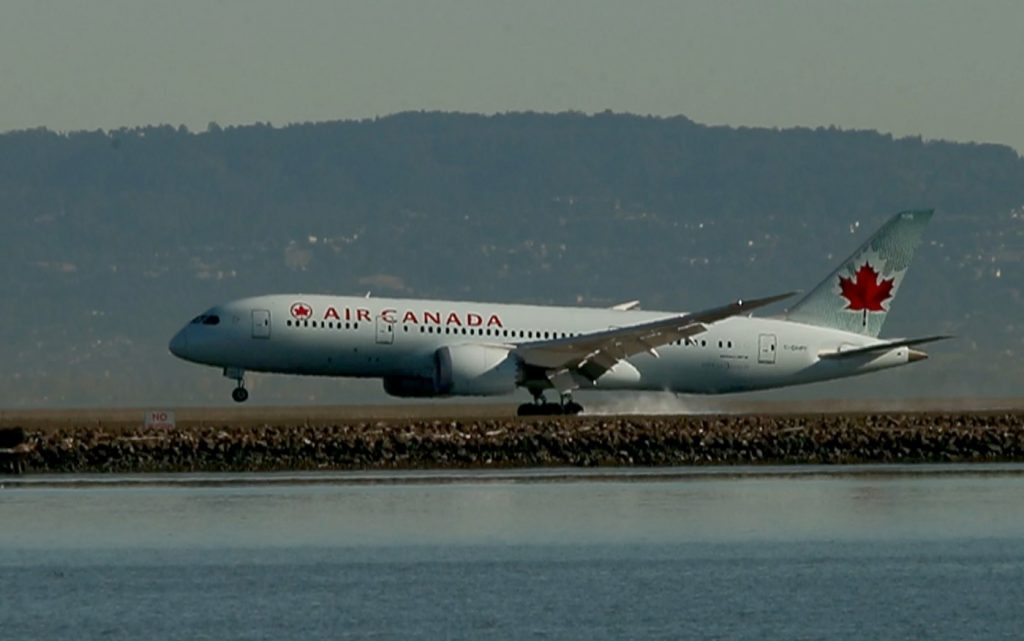Thanks to a bill President Biden signed Thursday, the federal government will finally implement much-needed safety measures to help prevent potentially deadly incidents at the nation’s airports.
It’s been more than six years since this news organization demanded changes after documenting a horrifying series of five airplane near-misses at San Francisco International Airport in less than 13 months.
In the most frightening, Air Canada pilots mistook the taxiway for the runway where they were supposed to land. The plane dipped to 59 feet off the ground and came within seconds of slamming into four fully fueled aircraft on the ground, endangering an estimated 1,000 passengers.
It could have been nearly the worst aviation disaster in history, second only to the two hijacked planes that plowed into the World Trade Center on Sept. 11, 2001.
In congressional testimony soon after, a federal auditor revealed that the annual number of runway “incursions” had increased nearly 83% from fiscal year 2011 to fiscal year 2017.
Then, last year, a comprehensive New York Times investigation similarly found that near-misses at airports across the country, including more recent examples at SFO, were common.
But federal regulators at the National Transportation Safety Board, responsible for investigating such incidents, and at the Federal Aviation Administration, responsible for setting safety rules, seemed more concerned with guarding the airline industry’s reputation than protecting the flying public.
While there has been some progress, the agencies have lacked the needed laser focus on reform. That should soon change, thanks to the bill Biden signed reauthorizing and funding the federal aviation programs at the NTSB and FAA.
The bill has received widespread press coverage for its consumer protections requiring automatic refunds when a flight is canceled, delayed or significantly changed. But the bill also contains critical and long-overdue safety provisions to address the near-misses.
It should not have taken six years and an act of Congress to fully implement these commonsense provisions.
The Federal Aviation Administration could have acted administratively a long time ago, says Rep. Mark DeSaulnier, D-Concord. “But they didn’t because they were too close to the industry.”
Since 2017, DeSaulnier has been a leading congressional advocate for safety reforms. Key provisions of a bill he drafted were incorporated in the reauthorization, which he emphasizes was a bipartisan effort. Indeed, the bill passed the Senate on an 88-4 vote and the House by 387-26.
To be fair, the FAA had already begun taking steps to avert future runway incidents. But it didn’t go nearly far enough. The authorization bill makes clear the congressional priority to protect passengers.
For example, as the investigation following the Air Canada incident highlighted, cockpit voice recorders had continuous loops that tape over themselves after 30 minutes to two hours of flight time, depending on the specific equipment. Delays in reporting the SFO incident resulted in the tape being recorded over.
The voice recorders are critical to investigations and prevention of future incidents because they capture the communications between pilots in the cockpit. Those conversations can provide insight into what the pilots were thinking and doing — such as why they would mistake a taxiway for a runway or, as in another Air Canada near-disaster at SFO, why they would ignore six orders from the control tower to abort their landing.
The FAA has started a rule-making process to increase cockpit voice recorders to 25 hours, but only for new aircraft. The reauthorization bill expands that to require 25-hour cockpit voice recorders on existing aircraft.
Related Articles
Editorial: In Berkeley, elect Hernández Story for vacant council seat
Editorial: California’s love affair with fiber threatens efforts to bridge digital divide
Editorial: We sued OpenAI to stop its exploitation of our work
Editorial: Dublin women’s prison closure rife with abuse and court secrecy
Editorial: Bay Area school officials’ shameful tax-election manipulations
Similarly, the federal agency has been slow to require installation of technology that could minimize runway-collision risks. Airport surface surveillance systems track the movements of planes and vehicles and can alert air traffic controllers or flight crew of possible runway obstacles.
The FAA has deployed these systems at approximately 40 airports, but the authorization bill clarifies that all medium and large hub airports, about 60 airports in all, must have this technology within five years.
The bill also requires speeding up hiring and training of badly needed air traffic controllers, a study of runway incidents and the creation of a task force to identify the human factors that contribute to safety risks.
It’s progress. It’s taken too long. We’ve been lucky so far. Let’s hope the changes will be fully implemented before our luck runs out.


